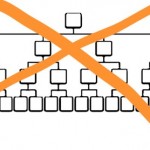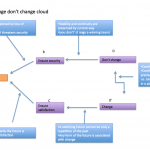Is there an organizational design that can replace the artificial barriers and fear of the traditional hierarchy? Digital cowboys, the new generation of talent described in Pekka Viljakainen’s book ‘No Fear’ , reject the form and values of the traditional organization. We continue our series in response to Pekka’s invitation to outline how we at […]
Can We Do Away With Hierarchy?
We look at hierarchy and how to change it as we continue our series on creating the no-fear environment for the 21st century organization for post-digital workers and managers in response to our invitation from ‘No Fear’ author Pekka Viljakainen. In order to create an organization that combines the two most fundamental elements of […]
Don’t Climb, Grow! Success in the Systemic Organization
We continue our series on creating the no-fear environment for the 21st century organization for post-digital workers and managers in response to our invitation from ‘No Fear’ author Pekka Viljakainen. What does a systemic organization look like? Let’s look first at the shape of the organization, i.e. the design. What kind of organization are we […]
Drive Out Fear by Learning to Think Systemically
Continuing our series in response to invitation by ‘No Fear’ author Pekka Viljakainen to outline how we would drive out fear from the workplace and how we would accommodate the post-digital generation of talent. At Intelligent Management, we support organizations in driving out fear through the adoption of the Decalogue™ methodology. This is a unique […]
No Fear in the Workplace – Making it Happen
We were invited by Pekka A. Viljakainen, author of ‘No Fear’, a book that addresses managing and leading a new generation of post-digital talent, how we would go about driving out fear from the workplace. The following posts are our response on achieving No Fear through a systemic organizational design and management methodology. Digital […]
Why change? Part 2
In Part 2 we look at how cause-and-effect reasoning and acknowledging our ‘cognitive constraints’ are crucial in understanding why, when, what and how to change. Dr. W. Edwards Deming used to warn about the consequences (cause and effect) of seemingly simple actions: “if we kick a dog in the street, we are responsible for the […]
Why Change? Part 1
In our previous post we looked at tools for the three phases of change (What to Change, What to Change to and How to Make the Change Happen). This post is in response to several comments that asked about the ‘why’ of change. Dr. W. Edwards Deming used to say: “The only thing that does […]
Change: Tools for Thinking, Planning and Enacting Change
Continuing our series on Change. In our previous post, we mentioned the three phases of change: what to change what to change to how to make the change happen For each of these phases, there is a powerful Thinking Process Tool from the Theory of Constraints (TOC). Let’s look at the three phases. What to […]
Change: Intuition, Understanding and Knowledge
Continuing our series on change. We live in an extraordinarily complex, post-digital world, where interdependencies and interconnections multiply at an ever-increasing speed. The cause-effect relationships that govern the world as we experience it create a super intricate ‘network of networks’ and we have a very limited understanding of the underlying properties of these networks and […]














